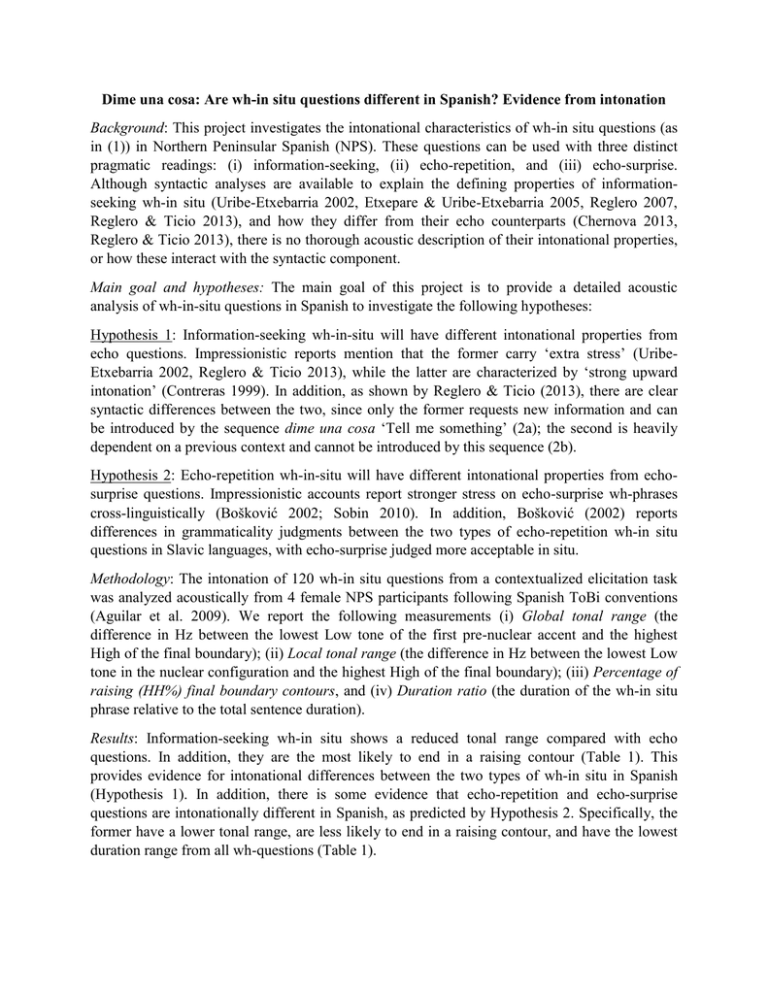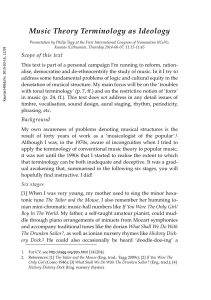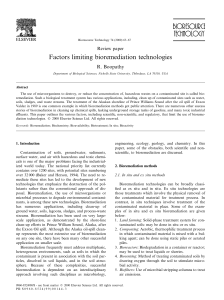Dime una cosa: Are wh-in situ questions different in Spanish
Anuncio

Dime una cosa: Are wh-in situ questions different in Spanish? Evidence from intonation Background: This project investigates the intonational characteristics of wh-in situ questions (as in (1)) in Northern Peninsular Spanish (NPS). These questions can be used with three distinct pragmatic readings: (i) information-seeking, (ii) echo-repetition, and (iii) echo-surprise. Although syntactic analyses are available to explain the defining properties of informationseeking wh-in situ (Uribe-Etxebarria 2002, Etxepare & Uribe-Etxebarria 2005, Reglero 2007, Reglero & Ticio 2013), and how they differ from their echo counterparts (Chernova 2013, Reglero & Ticio 2013), there is no thorough acoustic description of their intonational properties, or how these interact with the syntactic component. Main goal and hypotheses: The main goal of this project is to provide a detailed acoustic analysis of wh-in-situ questions in Spanish to investigate the following hypotheses: Hypothesis 1: Information-seeking wh-in-situ will have different intonational properties from echo questions. Impressionistic reports mention that the former carry ‘extra stress’ (UribeEtxebarria 2002, Reglero & Ticio 2013), while the latter are characterized by ‘strong upward intonation’ (Contreras 1999). In addition, as shown by Reglero & Ticio (2013), there are clear syntactic differences between the two, since only the former requests new information and can be introduced by the sequence dime una cosa ‘Tell me something’ (2a); the second is heavily dependent on a previous context and cannot be introduced by this sequence (2b). Hypothesis 2: Echo-repetition wh-in-situ will have different intonational properties from echosurprise questions. Impressionistic accounts report stronger stress on echo-surprise wh-phrases cross-linguistically (Bošković 2002; Sobin 2010). In addition, Bošković (2002) reports differences in grammaticality judgments between the two types of echo-repetition wh-in situ questions in Slavic languages, with echo-surprise judged more acceptable in situ. Methodology: The intonation of 120 wh-in situ questions from a contextualized elicitation task was analyzed acoustically from 4 female NPS participants following Spanish ToBi conventions (Aguilar et al. 2009). We report the following measurements (i) Global tonal range (the difference in Hz between the lowest Low tone of the first pre-nuclear accent and the highest High of the final boundary); (ii) Local tonal range (the difference in Hz between the lowest Low tone in the nuclear configuration and the highest High of the final boundary); (iii) Percentage of raising (HH%) final boundary contours, and (iv) Duration ratio (the duration of the wh-in situ phrase relative to the total sentence duration). Results: Information-seeking wh-in situ shows a reduced tonal range compared with echo questions. In addition, they are the most likely to end in a raising contour (Table 1). This provides evidence for intonational differences between the two types of wh-in situ in Spanish (Hypothesis 1). In addition, there is some evidence that echo-repetition and echo-surprise questions are intonationally different in Spanish, as predicted by Hypothesis 2. Specifically, the former have a lower tonal range, are less likely to end in a raising contour, and have the lowest duration range from all wh-questions (Table 1). Implications: The results obtained have implications for syntactic analyses of wh-in situ in Spanish. In particular, it validates recent claims that information-seeking wh-in situ questions are a completely different phenomenon from echo questions (Reglero & Ticio 2013). Further implications for the interaction between intonation and focus, and its consequences for movement and non-movement analyses of wh-in situ, will also be explored. Examples (adapted from Reglero & Ticio 2013) (1) Wh-in situ question ¿Tu padre compró qué? your father bought what? (2) Acceptability of wh-in situ questions with Dime una cosa ‘Tell me something’ a. Information-seeking (uttered in an out-of-the-blue context) Dime una cosa: ¿María se tomó un té con quién? tell-me one thing Mary CL had a tea with who? b. Echo-repetition Speaker 1: María se tomó un té con Cleopatra. Mary CL had a tea with Cleopatra Speaker 2: *Dime una cosa: ¿María se tomó un té con QUIÉN? tell-me one thing Mary CL had a tea with who? Table 1: Intonational differences in Spanish wh-in situ questions Information-seeking Echo-repetition Echo-surprise Local tonal range 144 Hz 163 Hz 192 Hz Global tonal range 133 Hz 154 Hz 172 Hz Percentage of final raising (HH%) contours 75% 45% 60% Duration ratio 31% 18% 27% Selected references Aguilar, Lourdes; De-la-Mota, Carme; Prieto, Pilar (2009). Sp_ToBI Training Materials. Web page: http://prosodia.upf.edu/sp_tobi/. Last accessed 11/12/2015. Bošković, Željko (2002). On mutiple wh-fronting. Linguistic Inquiry 33: 351-383. Chernova, Ekaterina (2013). El análisis sintáctico de las preguntas qu-in situ de eco en español. Verba 40: 65-92. Contreras, Heles (1999). Relaciones entre las construcciones interrogativas, exclamativas y relativas. In Ignacio Bosque and Violeta Demonte (eds.) Gramática descriptiva de la lengua española, 1931-1963, Madrid: RAE-Espasa Calpe. Reglero, Lara & Emma Ticio (2013). A unified analysis of wh-in-situ in Spanish. The Linguistic Review 30: 1-47. Uribe-Etxebarria, Myriam (2002). In situ questions and masked movement. Linguistic Variation Yearbook 2: 259-303.




